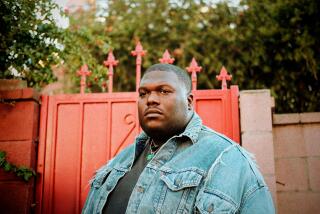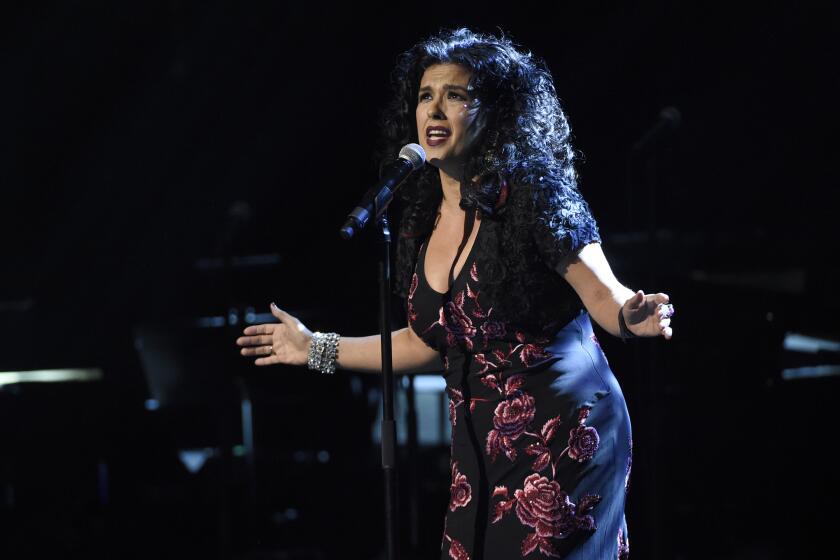Crips and Bloods ‘Bangin’ on Wax,’ Not on the Street : Producers bring together gang members in a unique cooperative venture--a rap album.
- Share via
The talk is tough as eight Los Angeles gang members sit around a conference table in Burbank.
“Normally we’d be shootin’ and killin’ each other,” Sin says without a trace of humor. He identifies himself as a member of the Crips, one of Los Angeles’ most notorious gangs--and he’s nodding toward some members of the rival Bloods gang as he speaks.
Pausing, he adds:
“It’s different now. You see, we’ve got this business thing . . . .”
The “business thing” that has brought 16 members of the Bloods and the Crips--roughly aged 11-to-mid-20s--together in a unique cooperative venture: a rap album.
Titled “Bangin’ on Wax,” it contains hard-core commentaries from the gang members about life in the ‘hood. It’s due March 9 from Quality Records--the company that also released a Lighter Shade of Brown’s hit single “Homies.”
Eight of the gang members--including a woman who identified herself as Bloody Mary--were at the Quality Records office in Burbank joking and chatting and downing junk food as if they’d been pals for years. “The point of this project is for gang members to battle with words, not bullets,” says Ronnie Phillips, a veteran independent record producer who sold the idea to Quality Records’ head man Russ began before he even had anything on tape. “There are peaceful ways to get out frustrations.”
“Amen, brother,” chimes in Tweety Bird Loc. A member of the Crips, he’s the only experienced rapper of the gang members involved in the project.
In a separate interview, Regan, an industry veteran who was instrumental in launching Elton John’s career in the early ‘70s, said he was intrigued by the idea of making a record with gang members.
“Also, it was a chance for us to make some money and do something useful for the community at the same time,” he says, noting that a portion of the revenues will be donated to community organizations. “We took a chance. The project could have been a bust.”
Despite using nearly all amateur rappers, most of “Bangin’ on Wax” sounds quite professional, getting a strong boost from the funky beats. One side is Crips’ material and the other belongs to the Bloods. At times, listening to the venomous verbal attacks is like being caught in a combat zone.
How did Phillips--never a gang member--get these natural enemies to collaborate?
“I just put out the word that we were organizing this album and all these gang members who wanted to be rappers showed up,” he replies. “The money was attractive. It made them overlook having to work with a rival gang.”
The album was recorded at a South-Central Los Angeles studio over an intense two-week period in January.
“There were some confrontations but nothing physical,” Phillips says. “Some people were very nervous at first. The studio owner started carrying a gun.”
For safety reasons, Phillips might have ordered a weapons check--but he didn’t. “It would have sent the message that I didn’t trust them,” he says. “A lot of them wouldn’t have showed up.”
Scheduling Bloods and Crips to record at different times would also have reduced tensions. “But that would have been phony,” insists production assistant J. Stank. “One of the main reasons for this project is for them to learn to work together.”
Regarding the music, most of the instrumental tracks were completed when the sessions started. Many of the raps, though, were written in the studio by the rappers themselves.
“Sometimes we had to get them off the track of blasting the other gang,” J. Stank recalls. “Too much of that would have been boring.”
In talking to these gang members, it’s hard to doubt their authenticity. But some skeptics undoubtedly will.
“We’d have to be pretty stupid to pretend like we’re real gang members,” says the Bloods’ Do-or-Die. “Wouldn’t the real Bloods and Crips come down on us hard? Why would we set ourselves up?”
The other doubt about the project that’s bound to surface: that the revenues will be used for further gang activity. That suggestion prompted wild laughter at the table.
“People think all we want to do is fight each other,” Sin says. “If most of us had plenty of money and could do something else, we’d do it.”
Phillips has a vision of this album triggering a massive lifestyle change throughout gangdom. “Some of these brothers are looking to get out of the gang life,” he explained. “Maybe some of them can get into the music business.
“This album could open doors for some of them and get them off the streets. We probably can’t stop all the gang killing but I’d be happy stopping some of it.”
More to Read
The biggest entertainment stories
Get our big stories about Hollywood, film, television, music, arts, culture and more right in your inbox as soon as they publish.
You may occasionally receive promotional content from the Los Angeles Times.









